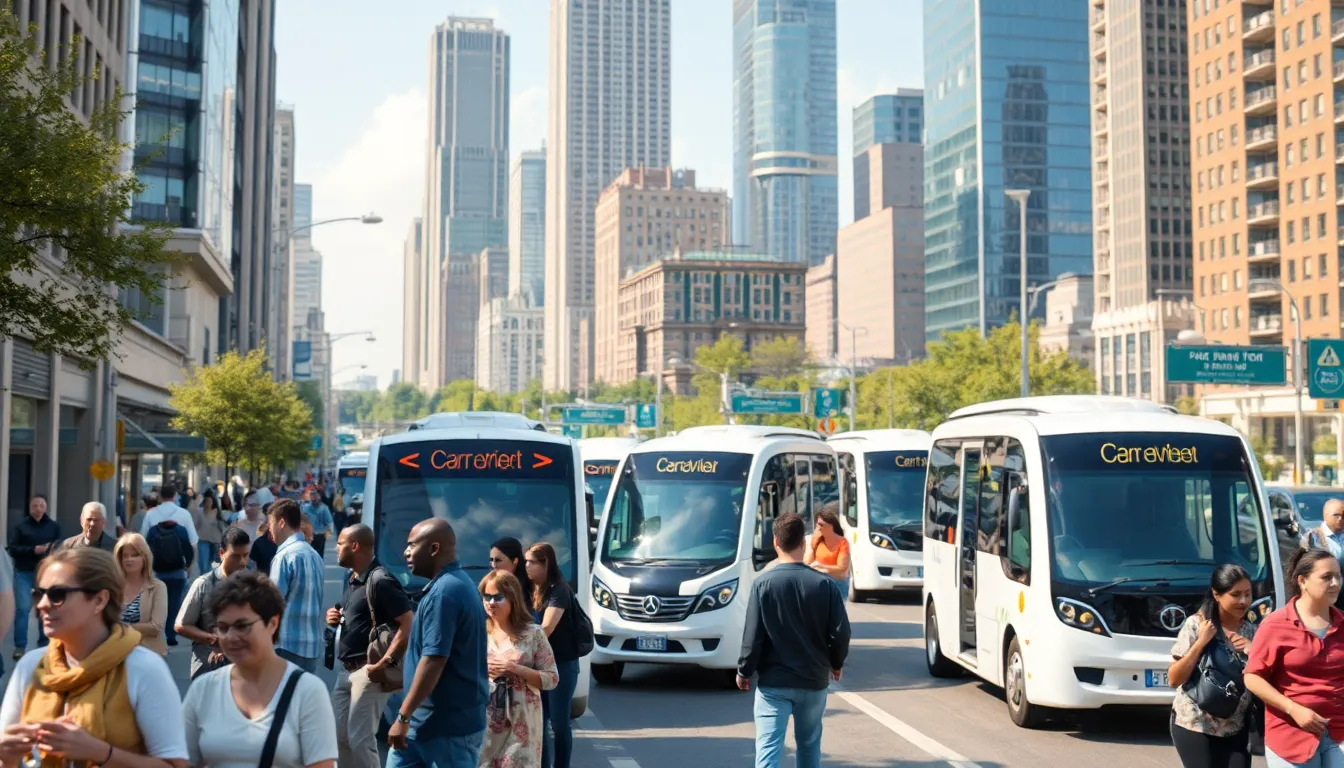Transportation has come a long way from the days of horse-drawn carriages and steam locomotives. As societies evolved, so did their methods of moving people and goods. Today, innovations in technology and design are reshaping how we think about travel, making it faster, safer, and more efficient.
From the advent of the automobile to the rise of electric vehicles and autonomous systems, each advancement has transformed the landscape of transportation. Understanding this evolution not only highlights human ingenuity but also sheds light on the challenges and opportunities that lie ahead in a world increasingly focused on sustainability and connectivity.
Table of Contents
ToggleHistorical Overview of Transportation Evolution
Transportation has transformed significantly over centuries. The progression from basic methods to sophisticated systems has played a crucial role in shaping societies.
Early Modes of Transport
Early transport methods included walking, animal domestication, and the usage of canoe-like vessels. Humans initially relied on foot for movement. Animal-led transport emerged around 4000 BCE with the domestication of horses, donkeys, and camels, enhancing travel and trade. Waterborne vessels, such as reed rafts and dugout canoes, facilitated commerce and exploration along rivers, lakes, and coastlines.
Development of Land Transportation
Land transportation evolved through several key stages. The invention of the wheel around 3500 BCE marked a pivotal advancement, leading to the development of chariots and carts. The Roman Empire expanded road networks to connect its territories, enabling efficient trade and military movement. In the 19th century, steam locomotives revolutionized land travel, introducing high-speed rail lines. The late 20th century saw the rise of automobiles, further revolutionizing personal and commercial transport, alongside the emergence of electric and hybrid vehicles in the 21st century.
The Industrial Revolution and Its Impact

The Industrial Revolution marked a significant turning point in transportation, introducing innovations that reshaped travel and trade. Key advancements in rail transport and road systems emerged during this era, laying the foundation for modern infrastructure.
Advancements in Rail Transport
Rail transport advanced dramatically with the introduction of steam-powered locomotives in the early 19th century. George Stephenson’s locomotive, “The Locomotion,” debuted in 1825, showcasing the potential of railways to move goods and passengers quickly. By 1860, over 20,000 miles of railway tracks spanned the United States, connecting major cities and facilitating commerce. Railroads enabled the mass movement of resources like coal and timber, spurring industrial growth. The introduction of standardized railway gauges allowed for greater compatibility, promoting efficiency across networks. Over time, rail transport evolved further with the development of electric trains and high-speed rail systems in the late 20th century, expanding the capacity and speed of intercity travel.
Transformation of Road Systems
Road systems also underwent significant transformation during the Industrial Revolution. The introduction of macadamized roads improved durability and accessibility, enhancing the movement of vehicles. The construction of major highways, such as the Turnpike Trusts in England, promoted trade and connectivity between urban and rural areas. Innovations in vehicular design, including the development of the bicycle in the 19th century, fostered new forms of personal transport. The period saw the emergence of motor vehicles, which began to replace horse-drawn carriages by the late 1800s. The advent of the automobile led to the establishment of local and national road networks, driving urban expansion. By the mid-20th century, interstate highways transformed road transport further, enabling efficient long-distance travel and commerce.
The Rise of Air Travel
Air travel emerged as a groundbreaking advancement in transportation, significantly altering the landscape of global mobility. The introduction of aircraft transformed travel, allowing individuals to traverse large distances in shorter time frames.
Milestones in Aviation History
A few significant milestones mark the journey of aviation:
- Wright Brothers’ First Flight (1903): Orville and Wilbur Wright achieved the first powered flight in Kitty Hawk, North Carolina, using the Wright Flyer.
- Commercial Aviation Begins (1914): The St. Petersburg-Tampa Airboat Line launched the first scheduled passenger airline service, carrying one passenger.
- Jet Age (1950s): The introduction of the de Havilland Comet marked the beginning of commercial jet travel, drastically reducing flight times.
- Wide-body Aircraft (1970): The Boeing 747 debuted as the first wide-body airliner, increasing passenger capacity and revolutionizing long-haul air travel.
- Low-Cost Carriers (1990s): The emergence of budget airlines made air travel more accessible, enhancing competition within the industry.
Impact on Global Connectivity
Air travel significantly enhanced global connectivity, allowing for rapid movement of people and goods across international borders. The development of major airports and global air traffic networks established seamless routes, fostering international trade and tourism.
Air travel’s efficiency facilitates quick business travel, strengthening economic ties among countries. Additionally, the rise of air travel increased cultural exchange, enabling diverse interactions across the globe. The ability to reach distant destinations in hours rather than days redefined personal and professional relationships, contributing to the world’s ever-evolving interconnectedness.
The Digital Age and Future Innovations
The digital age propels transportation into a new era marked by advancements in electric and autonomous technologies. Innovations in these areas promise to reshape how people and goods move across the globe.
Electric and Autonomous Vehicles
Electric vehicles (EVs) gain popularity due to environmental concerns and advances in battery technology. The global EV market surged to approximately 10 million units sold in 2022, up from 2 million in 2018. Major manufacturers, including Tesla, Ford, and Volkswagen, invest heavily in developing cutting-edge models that appeal to consumers and reduce emissions. Autonomous vehicles, employing artificial intelligence and advanced sensors, enhance safety and efficiency. In 2021, Waymo reported reducing collision rates by 94% compared to human drivers during test drives. Innovations in software and hardware continue to drive the potential for fully autonomous transportation systems, with projections indicating widespread adoption of these vehicles by 2030.
The Role of Public Transportation Systems
Public transportation systems evolve through the integration of digital technologies, improving accessibility and efficiency. Smart transit solutions like real-time tracking and mobile apps empower commuters with up-to-date information. In urban areas, mass transit ridership surged by 18% from 2019 to 2022 in cities like New York, driven by these advancements. Electrification of public transit, including battery-powered buses and trams, targets reduced carbon footprints. Cities such as Amsterdam and San Francisco exemplify successful implementations of electric public transportation, showcasing lower operational costs and enhanced urban air quality. Looking forward, investments in multimodal transport options are crucial for creating seamless transit experiences that meet growing urban population demands.
Environmental Considerations in Transportation Evolution
Transportation evolution incorporates significant environmental considerations. Sustainability plays a critical role in shaping future transport solutions, influencing policies, and driving innovation across industries.
Sustainability Efforts
Sustainability efforts focus on reducing the environmental impact of transportation systems. Many countries implement stricter emissions regulations to promote cleaner alternatives. For instance, electric vehicle (EV) incentives encourage consumers to transition away from fossil fuels. Charging infrastructure expands in urban areas, making EV adoption more feasible.
Public transport systems also evolve, incorporating low-emission buses and trains. Cities like London and Paris invest in electric and hybrid options to decrease air pollution. Bike-sharing programs and pedestrian-friendly designs further promote sustainable travel habits. Investment in renewable energy sources for charging stations significantly decreases reliance on carbon-intensive electricity.
Impact of Technology on Carbon Footprint
Technology influences the transportation sector’s carbon footprint dramatically. Innovations in fuel efficiency extend the driving range while minimizing emissions. Advanced materials in vehicle manufacturing reduce weight, leading to lower energy consumption.
AI and data analytics optimize traffic flow, reducing congestion and environmental impact. Smart traffic management systems decrease idling time, lowering emissions significantly in urban areas. Additionally, autonomous vehicles promise enhanced efficiency through car-sharing models, resulting in fewer vehicles on the road.
Monitoring systems track emissions in real time, allowing for rapid adjustments to minimize environmental impact. Tech-driven solutions emphasize sustainable practices, urging the industry toward greener methods.
The journey of transportation has been nothing short of remarkable. From simple beginnings to complex systems that connect the globe today, each advancement has shaped how people and goods move. As society faces pressing environmental challenges, the focus on sustainability and innovation in transportation is more vital than ever.
Emerging technologies like electric and autonomous vehicles are paving the way for a cleaner future. Cities are embracing smart transit solutions to enhance efficiency and reduce emissions. The evolution of transportation is a testament to human ingenuity and adaptability, promising exciting developments ahead as we strive for a more connected and sustainable world.



